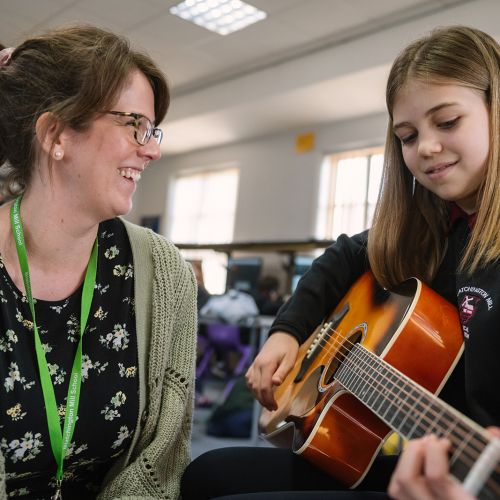Information About Progress Reports





At Blatch, we know our students are much more than a report - there are many moments of triumph and successes in our students' lives, of which you and they will feel a sense of pride or satisfaction. Indeed, there will be personal areas for development each child is working on that are not fully covered in a school report.
Progress reports are however a useful snapshot from which to speak to your child about how to harness their successes and also how to apply themselves in their areas for improvement. Please find a list of key assessment and reporting dates for each year group below:
Year 7
Please find the key assessment dates for Year 7 here [pdf]
Year 8
Please find the key assessment dates for Year 8 here [pdf]
Year 9
Please find the key assessment dates for Year 9 here [pdf]
Year 10
Please find the key assessment dates for Year 10 here [pdf]
Year 11
Please find the key assessment dates for Year 11 here [pdf]
Below is some further explanation and guidance about what we report on to support you recognising and celebrating your child's achievement and having informed conversations about their progress.
Progress:
We use A/O/B grades to tell you if your child is on, above or below expectations. These expectations were set in Y7 where all the assessment marks that year formed a baseline for each child. Above means a student has exceeded where we projected them to be based on assessments in Y7, they are in the top 20% of students for making progress. On means a student continues to improve and make the good progress we hope. Below means a student is not hitting the levels they are capable of.
We are highly aspirational for our students and this approach shows how their assessment scores compare to where we expect them to be. It allows us to recognise achievement no matter a child’s starting point. We know students can excel or struggle in certain topics or start from lower start points than others so our Above/On/Below progress measure focuses on whether students are improving rather than achieving certain grades. As an inclusive school, we like this because it is fair and rewards effort for all.
Mastery Level Descriptors:
At KS3, for technology and performance based subjects, including PSHE, students will be awarded mastery level descriptors. As these subjects require the development and deepening of skills over time, we believe that a more descriptive comment of students' current ability provides a better indication of their progress than raw assessment scores. The mastery level descriptors for Art, Computing, Design, Drama, Food, Music, PE and PSHE are as follows:
|
Mastery Level |
Description |
|
Foundational |
Students are beginning to grasp some of the knowledge and skills required to succeed in this subject and can demonstrate these in a limited way that lacks detail. They are not yet confident when communicating ideas. They need additional teacher support to complete a task. |
|
Developing |
Students understand a range of knowledge and skills and can demonstrate these with some confidence. Their work shows growing technical ability but frequently depends on teacher support. |
|
Confident |
Students demonstrate a good understanding of knowledge and skills when applying work to ideas they are familiar with. Students can make choices independently to complete work successfully showing confidence. The quality of their work is consistently good. |
|
Exceptional |
Students have developed exceptional knowledge and skills allowing them to apply their learning to unfamiliar ideas. They are confident when working independently and their work is of a consistently excellent standard. They can use their creativity to develop and demonstrate new ideas. |
Raw Assessment Scores:
Knowing the ‘raw’ mark and what the test was out of indicates how well a student has done in that assessment and when the teacher gives feedback, tells students what was known and not known in an assessment. This is the most important part - it tells students what to revise.
Sometimes we are asked for grades on individual assessments, however awarding grades for individual pieces of work is neither reliable nor valid. GCSE grades are designed for whole courses completed by the end of Y11, not single assessments with a small mark range. In Y7-9 there are no national grade boundaries or levels to use so schools decide how best to signify progress because any system only applies to that school. Grades do not actually tell parents/carers the standard their child is reaching.
We also know that there is a ‘cliff edge’ effect when awarding grades because the subjectivity in marking makes comparing grades awarded between classes less reliable. The small mark ranges needed on individual assessments (e.g. 3-4 marks per grade) mean that grade boundaries are artificially close together. 1 mark makes a huge difference, and can mean work that is of equal quality is awarded different grades in different classes. Grading has an unnecessarily negative impact, labelling students with certain grades that may not reflect their ability. It is an unnecessary extra layer of detail distracting from the most important thing - where marks were gained/dropped and the actual feedback on how to get better!
Average Mark:
The average mark shared is the average mark of all the students on this assessment - the total marks divided by the total number of students.
Top 20% Mark:
The top 20% mark is the mark gained by the highest scoring 20% of students in the assessment in this subject.
Current Grade (KS4 Reports Only):
This is your child’s current working grade for the components of their GCSE courses that have been taught. It provides a useful comparison point with a student's target potential.
Target Grade Potential (KS4 Reports Only):
In KS4, students will receive a target grade range for each subject, which represents their potential for attainment in each subject. The target grade is based on a student’s potential for achievement in a particular subject. Like a predicted grade, it is not a guaranteed grade. It is represented as a range in grades, rather than a fixed grade, as potential is not fixed, but is based on numerous factors, and especially upon a student’s commitment to their learning in a subject. The target grade range is deliberately aspirational, and suggests what is possible for students to attain if they consistently work to the best of their ability. Grades are given a fine level of + or -. In this grading scale a ‘+’ (e.g. 5+) represents a high level within the grade boundary, a ‘-‘ (e.g. 5-) represents a lower level within the grade boundary.
Work Ethic:
Each teacher makes judgements in 3 categories for every student based on the student’s work and conduct, including preparation for and performance in assessments, quality of classwork and their effort towards learning in school. Work Ethic is graded in the 3 areas for each subject as either: ‘Outstanding’, ‘Good’ or ‘Improvement Needed’.
You can see more detailed Work Ethic descriptors below:

What does this look like in the classroom?
| Work Ethic Category | Outstanding | Good | Improvement Needed |
|
Behaviour for Learning |
Respects their teacher and peers by always showing self control in the way they behave so that everyone can learn and the teacher to support other pupils.Regulates their behaviour consistently well by following class routines and focusing fully on tasks in the manner instructed.A model student in terms of conduct and effort.Will always listen carefully to others, speak kindly and participate well in discussions as well as treat equipment with respect. | Respects their teacher and peers by mostly behaving in a way that allows everyone to learn and the teacher to support other pupils, with only occasional lapses.Will regulate their behaviour by following class routines most of the time and focusing on tasks in the manner instructed with occasional reminders but generally good effort.Listens to others in most instances, and speaks kindly and participates properly in most discussions, as well as treating equipment with respect. | Does not show enough respect for others because their behaviour can disrupt other pupils’ learning and can make it harder for the teacher to support all pupils.Does not follow class routines effectively and has patchy focus on learning, often needing reminders to stay on task or regulate behaviour, including minimal effort.Listens inconsistently to teacher instructions consistently, can use negative language when talking with peers and will not always treat equipment with respect. |
| Attitude to Learning | Consistently seeks to better themselves by undertaking challenging work and producing a high standard of work.Embraces positivity toward learning by putting in high levels of effort and concentration into their work.Proactive in approach, relying on themselves to complete a task to the best of their ability seeking help only when really needed (e.g. to challenge themselves or seek clarification). | Makes a concerted effort in most lessons to complete class work to a good standard.Demonstrates an appropriate attitude to tasks and challenges over time, whilst being generally positive about their learning and not giving up.Mostly proactive in their approach and in seeking support, concentrating on their work most of the time with only occasional prompts. | Does not make enough effort to completeclasswork to an appropriate standard relative to their ability or their peers.Passive in lessons and too negative about their ability and about tasks set, often giving up or asking for support too easily relative to their ability.Does not concentrate adequately on tasks, needing too many prompts to stay on task relative to their peers and any additional needs. |
| Readiness for Learning | Always arrives on time and settles quickly to learn.Always equipped for class and in correct uniformAlways submits homework on time. | Mostly arrives on time and settle into learning.Mostly equipped for class and in correct uniformSubmits most homework on time. | Can regularly arrive late or not settle quickly enough sometimes causing delaysEquipment or uniform is not right and needs to be addressed.Homework is not handed in on time regularly enough. |

